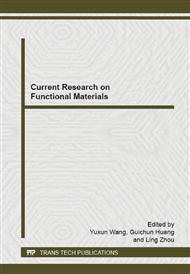[1]
Green, M.A., Estimates of Te and In prices from direct mining of known ores. Progress in Photovoltaics: Research and Applications, 2009. 17(5): pp.347-359.
DOI: 10.1002/pip.899
Google Scholar
[2]
U.S. Department of Energy, Critical Materials Strategy, December2010, Figure 7-9.
Google Scholar
[3]
A. Feltrin, A. Freundlich, Material Considerations for Terawatt Level Deployment of Photovoltaics, Renewable Energy 33(2008)180–185.
DOI: 10.1016/j.renene.2007.05.024
Google Scholar
[4]
B.A. Andersson, Material savailability for large-scale thin-film photovoltaics, Prog, Photovoltaics 8(2000)61-76.
DOI: 10.1002/(sici)1099-159x(200001/02)8:1<61::aid-pip301>3.0.co;2-6
Google Scholar
[5]
Sugimoto, H., et al. Achievement of over 17% efficiency with 30× 30cm 2-sized Cu (InGa) (SeS) 2 submodules. in Photovoltaic Specialists Conference (PVSC), 2011 37th IEEE. 2011. IEEE.
DOI: 10.1109/pvsc.2011.6186681
Google Scholar
[6]
Persson, C., Electronic and optical properties of Cu2ZnSnS4 and Cu2ZnSnSe4. Journal of Applied Physics, 2010. 107(5): p.053710.
DOI: 10.1063/1.3318468
Google Scholar
[7]
Mitzi, D.B., et al., The path towards a high-performance solution-processed kesterite solar cell. Solar Energy Materials and Solar Cells, 2011. 95(6): pp.1421-1436.
DOI: 10.1016/j.solmat.2010.11.028
Google Scholar
[8]
Todorov, T.K., et al., Beyond 11% Efficiency: Characteristics of State-of-the-Art Cu2ZnSn (S, Se) 4 Solar Cells. Advanced Energy Materials, 2013. 3(1): pp.34-38.
Google Scholar
[9]
Guo, Q., et al., Fabrication of 7. 2% efficient CZTSSe solar cells using CZTS nanocrystals. Journal of the American Chemical Society, 2010. 132(49): pp.17384-17386.
DOI: 10.1021/ja108427b
Google Scholar
[10]
Repins, I., et al., Co-evaporated Cu2ZnSnSe4 films and devices. Solar Energy Materials and Solar Cells, 2012. 101: pp.154-159.
DOI: 10.1016/j.solmat.2012.01.008
Google Scholar
[11]
Ahmed S, Reuter KB, Gunawan O, Guo L, Romankiw LT, Deligianni H. A high efficiency electrodeposited Cu2ZnSnS4 solar cell. Advanced Energy Materials 2012; 2: 253–259.
DOI: 10.1002/aenm.201100526
Google Scholar
[12]
Chen, S., et al., Classification of Lattice Defects in the Kesterite Cu2ZnSnS4 and Cu2ZnSnSe4 Earth‐Abundant Solar Cell Absorbers. Advanced Materials, 2013. 25(11): pp.1522-1539.
DOI: 10.1002/adma.201203146
Google Scholar
[13]
Redinger, A., et al., Detection of a ZnSe secondary phase in coevaporated Cu2ZnSnSe4 thin films. Applied Physics Letters, 2011. 98(10): p.101907.
DOI: 10.1063/1.3558706
Google Scholar
[14]
Vora, N., et al., Phase identification and control of thin films deposited by co-evaporation of elemental Cu, Zn, Sn, and Se. Journal of Vacuum Science & Technology A, 2012. 30(5): p.051201.
DOI: 10.1116/1.4732529
Google Scholar
[15]
Hsu, W.C., et al., Growth mechanisms of co‐evaporated kesterite: a comparison of Cu-rich and Zn-rich composition paths. Progress in Photovoltaics: Research and Applications, (2013).
DOI: 10.1002/pip.2296
Google Scholar
[16]
Marcano, G., et al., Crystal growth and structure of the semiconductor Cu2SnSe3. Materials Letters, 2002. 53(3): pp.151-154.
DOI: 10.1016/s0167-577x(01)00466-9
Google Scholar
[17]
Uday Bhaskar, P., et al., Investigations on co-evaporated Cu2SnSe3 and Cu2SnSe3–ZnSe thin films. Applied Surface Science, 2011. 257(20): pp.8529-8534.
DOI: 10.1016/j.apsusc.2011.05.008
Google Scholar
[18]
Shimada, T., F.S. Ohuchi, and B.A. Parkinson, Thermal decomposition of SnS2 and SnSe2: Novel molecular‐beam epitaxy sources for sulfur and selenium. Journal of Vacuum Science & Technology A, 1992. 10(3): pp.539-542.
DOI: 10.1116/1.578184
Google Scholar
[19]
Hergert, F. and R. Hock, Predicted formation reactions for the solid-state syntheses of the semiconductor materials Cu2SnX3 and Cu2ZnSnX4 (X= S, Se) starting from binary chalcogenides. Thin Solid Films, 2007. 515(15): pp.5953-5956.
DOI: 10.1016/j.tsf.2006.12.096
Google Scholar


